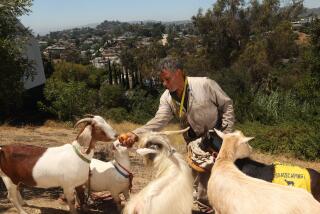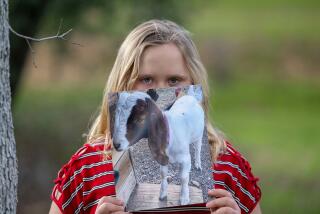The Devil Be Hanged, Scottish Farmers Try Raising the Hated Goat for Big Profit
- Share via
KINLOCHARD, Scotland — “Finn!” John Barrington, in his kilts, calls out. “That’ll do, Finn!”
The black-and-white dog crouches on the rough hill, at attention. Then Barrington whistles and she rockets forward to flank the small herd.
Finn is a sheep dog, and the dark-bearded Barrington is a shepherd. But the animals they are badgering down toward the loch-side Ledard Farm aren’t the usual pastoral sheep.
They’re big, mean-looking wild goats, part of a bold experiment here in the hill country 50 miles west of Edinburgh.
Profit Incentive
Fergus Wood, with the help of flock master Barrington, is one of a handful of farmers trying to raise a super breed of cashmere-bearing goats in Scotland. They’re doing it in sheep country, where goats are scorned as pests and friends of the devil.
The incentive is profit. A kilo (2.2 pounds) of cashmere fetches $105, while the same amount of wool brings only $1.75.
Tweed and tartan may be subject to the vagaries of fashion, Wood said, but “the thing that never goes out of demand is cashmere. That’s because it’s luxurious.”
Scotland imports 99% of the cashmere it uses in its famous sweaters and other knitwear products, said Wood, who also is a director of the Edinburgh-based Scottish Woolen Industry trade group.
Largest Consumer
Scotland is the largest consumer of the world’s cashmere crop, taking in more than 40% of it, he said. Most of it comes from breeds of goats in China, Mongolia and Afghanistan.
“Logically, the most ideal supplier of cashmere would be a domestic supplier,” Wood said.
Easier said than done.
“I think the biggest problem is the natural reticence of farmers to handle goats,” Wood said. “It’s just been a prejudice farmers have.”
That’s hard to believe, because the goat was the most agriculturally popular animal in Scotland 200 years ago, Wood said.
Celtic Folklore
But according to Celtic folklore, Barrington said, you can’t keep your eye on a goat for 24 hours, because at some point it goes off to have its goatee brushed by the devil.
No wonder the locals at the nearby Alstkeith pub poke fun of Woods’ venture.
But the European Economic Community and Scottish Development Agency have provided the breeders with $875,000 to get started.
Five farmers have set up a cooperative called Cashmere Breeders Ltd., which is acquiring what they call “the best genetic sources from abroad.”
Winter Coat
Cashmere is the down that goats grow under their outer coat during winter. It is harvested by combing.
All breeds produce cashmere, except the Angora goat, which grows a single mohair coat.
The breeders hope to raise 1.5 million to 2 million high-yield goats in herds of 50 to 250 animals within 10 years.
There are an estimated 120,000 goats in Britain today, compared to 35 million sheep, Wood said.
Improved Pastures
Wood has 200 cashmere goats on his 300-acre farm, on which he also raises sheep.
“You have the goats eating the nettles and things like brambles and the sheep eating the finer and more nutritious grasses,” Barrington said.
That improves pasture, which is an important consideration since the government doesn’t subsidize such improvements, Barrington said.
The flock master is enough of a traditionalist that he wears a kilt of the red-and-black plaid Glengyle MacGregor tartan. But he is enthusiastic about the new venture with cashmere-producing goats.
“It will be a great pity if farmers miss this opportunity,” Barrington said.
More to Read
Sign up for Essential California
The most important California stories and recommendations in your inbox every morning.
You may occasionally receive promotional content from the Los Angeles Times.













